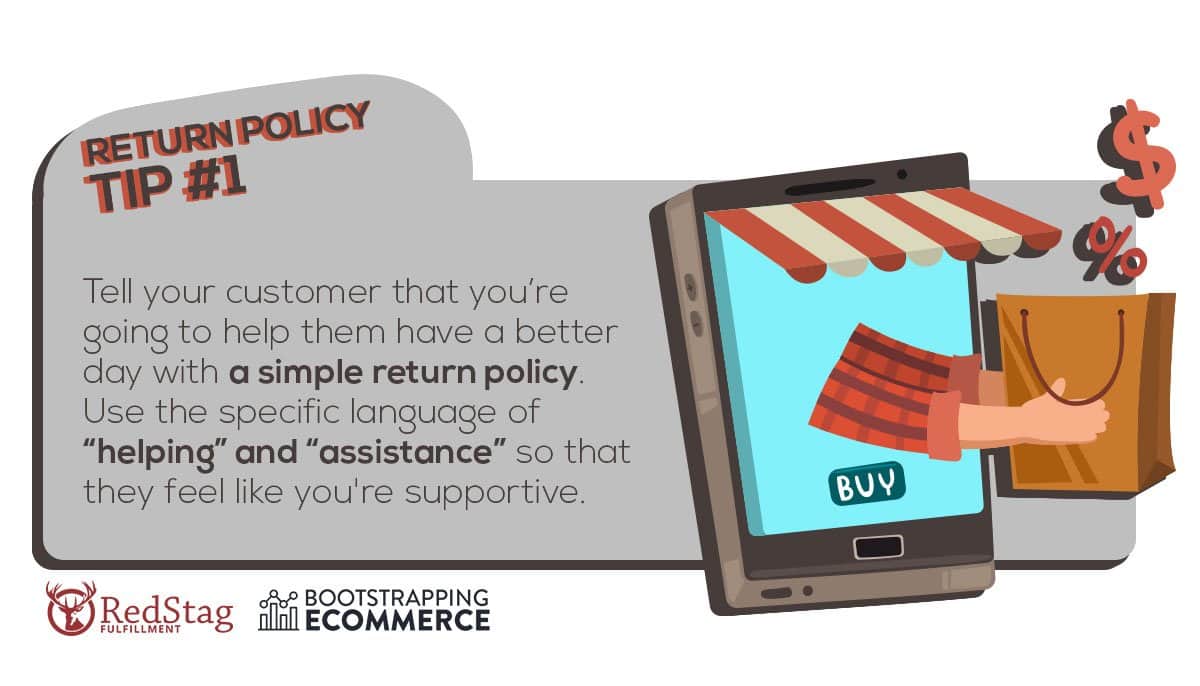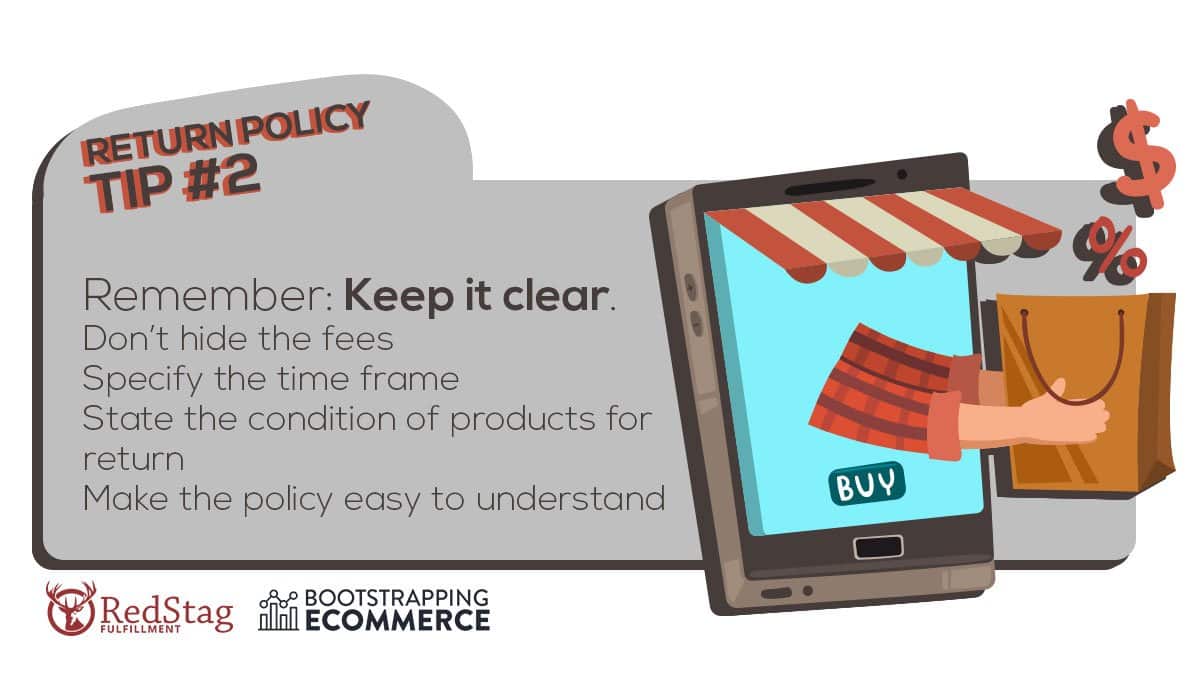You can’t please all the people all the time, so when it comes to ecommerce, some customers are going to return what they’ve bought from you. It can’t be avoided, but you can take steps with your return policy to make it as painless as possible for you and your customers.
The great news about returns in the ecommerce space is that they can actually present you with an opportunity if they’re handled right. A smooth and generous process will help you build a better relationship with your customers, potentially increasing their customer lifetime value (CLV). You can sell more by being a kinder store.
Here are eight big things to keep in mind to create a return policy that is best positioned to increase that CLV and maybe even earn you some positive reviews and acclaim on social media.
Return Policy Tip #1: Know Your Purpose
The first thing to do before you put pen to paper, or fingers to the keyboard, is to think about the true purpose for your return policy. Here’s a hint: It isn’t to get your stuff back.
Return policies are a step in the customer service cycle designed to achieve one very specific thing: Increase your sales.
When a customer wants to return a product, you’re essentially losing a sale. (You also are likely to lose future sales by simply having a “no returns” policy, but that’s a topic for another day.) The return policy is your framework to turn this interaction around and make the customer so happy that they want to buy from you again.
You often see companies try to help push this sale along by offering deals or coupons after someone returns a product. What they’re trying to do is get back to neutral, or into the positive territory, by selling something else that—at a bare minimum—offsets shipping, return, and restocking costs.
Return Policy Tip #2: Choose How You Want to Help
Tell your customer that you’re going to help them have a better day with a simple return policy. Use the specific language of “helping” and “assistance” so that they feel like you’re supportive. Beyond just saying you’ll help, you must decide how to provide that support.
Your two main options are direct refunds or in-store credit. Ecommerce brands can easily choose between either—or even offer both—so think about what’s right for you. If you’re not sure, offer a full refund, because this is less likely to alienate purchasers who are dissatisfied and not yet ready to exchange goods.

Return Policy Tip #3: Write it Clearly
The best objective when writing out your return policy is to make it as clear as possible. Follow the next sections to define your return policy and then send it around to people in and outside of your business. Ask if anything is confusing or if there’s anything they don’t like.
The secret here is that you’re not a lawyer. Trying to write like one can backfire. You may accidentally say something you don’t mean, or your policy may look so foreboding that people throw up their hands, keep your products they don’t like instead of returning them, and decide to shop elsewhere in the future.
Keep it simple and you’ll be in good shape. It also reduces the likelihood that someone will argue with your sales or customer service team claiming they didn’t understand the policy. The shorter these requests are, the less time you’ll spend on activities that don’t generate money for your store.
Return Policy Tip #4: Don’t Hide Fees
“Clear” is going to be a consistent motto for us on this journey. Perhaps the most important thing for you to be direct about is the cost the customer faces for returning anything you sell.
Determine if you’re going to pay for any costs like shipping and restocking, or if you require the customer to pay for them. No matter the decision, state this plainly in your return policy.
Put yourself in the shoes of a customer. You ordered something online, waited for it, and when it arrived something wasn’t right. So, you return it for a different size or color but discover that you’ve been charged an extra $6.
Essentially, you’ve paid $6 more just to get the thing you wanted how you wanted it. Would you buy from that store again?
Customers will be more willing to pay for a return if they know about it ahead of time. However, fees coming as a surprise is a way to create angry customers very quickly.

Return Policy Tip #5: Specify Time, Condition & More
The most important definition in your policy is what you require to accept a return. The core aspects of this are the timeframe for returns as well as the condition of the products. Write this as plainly as possible and have it in your return policy text at least twice.
If you’re not sure what to do, consider the standards of a 15 to 30-day window. Accepting returns after this may increase the number of unacceptable returns you get as well as increase the potential for fraud.
Just like with time, state condition. People will return a broken or defective product, and you should accept these. However, you might need to specify some requirements, such as parts in the original packaging or certain things like tags not having been removed.
Not discussing the condition may lead customers to attempt to return goods after they’ve been used or broken during use. If this is the case, you’ll be getting things you can’t resell and have to figure out how to accept these items or deny them and mail them yet again back to the consumer.
Different types of products have different return rates, so you may want to specify different rules for them if you have a wide set of items. Consider presenting the second mention of these items as a list. It keeps things clean, simple and makes it easy for customers to understand what you require of them.
Return Policy Tip #6: Make Your Policy Easy to Find
Ecommerce stores have a lot of lovely real estate. You can make just about as many pages as you want, and the same goes for sections of existing pages. Use this for your return policy.
You want a complete policy page that explains everything and is as complete as possible.
Next, you want to distill that down to a couple of sentences that say you have a return policy, give the time window, and tell the customer to “Read More Here” to learn about the condition that you require. Feature this snippet on your homepage, product pages, and your shopping cart pages. Stick a link in the footer as well.
To be safe, deliver your policy, too. Put a link to your return policy in the confirmation emails you send out or the confirmation pages you provide. Then, put a printed copy in all the shipping boxes you send. Make it standard and add it to everything, even if you’re packing up a box that is part of a return or exchange.

Return Policy Tip #7: Train Your Staff
Many policies have strict requirements, and some have exceptions to posted rules—the only exception you should ever consider is when you’re willing to give the customer the benefit of the doubt or a little more wiggle room; never less.
Posting this online is only the first part. Following it is the second.
Take time to teach your staff about the policies and requirements. Give them specific, direct training on what qualifies as a valid return, what you won’t take back, and who to turn to if they’re unsure about a situation.
Poorly trained staff can take returns they shouldn’t, harming your business through product loss. Or, they may deny returns that you promised to accept, causing anger and harming your business through customer loss.
Return Policy Tip #8: Try to Prevent the Return
The last thing we want to get you to think about is what happens before the return. Review your site, reviews, and more.
Ask yourself: Are you creating a false impression about the products you sell? Is the size or color chart unhelpful, unclear, or incorrect?
Customers return goods when they’re unhappy. If you review your site and products with that eye, you might be able to find out what is causing any misconceptions. Sometimes it is hype-y language that sets expectations too high. You might have poor product photography, an incorrect description or be accidentally displaying the wrong information and reviews.
Look for ways to improve your product pages, and you might be able to prevent a few returns and have even happier customers!








